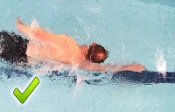Swimming in open water, like lakes, rivers, and oceans, is one of the biggest factors which prevent athletes from becoming triathletes. There are many real concerns that stop beginner swimmers from signing up for their first race. Training in the safety and comfort of a pool is far different from racing in the open water. In a pool, there are lifeguards near by, lane lines to grab hold of, crystal clear water, and relatively shallow depth to stand up in.
While the concerns and fears potential triathletes have are real, they can be suppressed and overcome with the proper amount of knowledge and practice. This article discusses different areas of concern new swimmers may have about racing in open water along with tips and suggestions on how to swim past these issues and on to the finish line.
1. Swimming in deep water
One of the biggest fears that triathletes must overcome is swimming out in the middle of a lake where they can not touch the bottom. Many new swimmers have little anxiety about deep water in the pool because they can stand in most areas and if need be, they can hold on to the lane lines. The anxiety can grow, though, when you are in the middle of a lake. The nearest buoy or lifeguard on a paddle board may appear like small dots in the distance. Having a high level of confidence and comfort in deeper water can be beneficial if you struggle during your swim.
Two skills you can work on to bring confidence for when you swim in deep, open water are treading water and swimming breast stroke. Being able to tread water allows you to catch your breath and assess where you are in the water, without wasting too much energy. Breast stroke is known as a rescue stroke because it does not use a lot of energy and you can keep your head above water to catch your breath and focus your eyes in front of you. Having the ability to relax and keep yourself afloat in deep water will make you more confident if you find yourself struggling in the middle of a race.
Tip: A fun way to practice treading water is to play a game of water polo in the deep end of the pool. This will improve your treading skills and your level of fitness, all while having fun!




